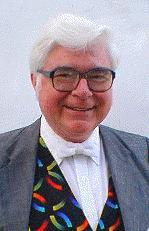Robert L. Forward facts for kids
Quick facts for kids
Robert L. Forward
|
|
|---|---|
 |
|
| Born | August 15, 1932 Geneva, New York, U.S.
|
| Died | September 21, 2002 (aged 70) Seattle, Washington, U.S.
|
| Alma mater | University of Maryland UCLA |
| Known for | Statite |
| Spouse(s) | Martha Dodson (1954–2002; his death) |
| Children | Robert Dodson Forward Mary Lois Mattlin Julie Elizabeth Fuller Eve Laurel Forward |
| Scientific career | |
| Fields | Physicist |
| Institutions | Hughes Aircraft Tethers Unlimited, Inc. |
| Thesis | Detectors for Dynamic Gravitational Fields (1965) |
| Doctoral advisor | Joseph Weber David Mandeen Zipoy |
Robert Lull Forward (born August 15, 1932 – died September 21, 2002) was an American physicist and science fiction writer. He was known for making his science fiction stories incredibly realistic. He used ideas from his work as an aerospace engineer to make his books scientifically accurate. He also helped a lot with research on how to find gravitational waves.
Contents
Robert L. Forward's Life Story
Robert L. Forward earned his special advanced degree, called a doctorate, from the University of Maryland in 1965. His main project for this degree was about "Detectors for Dynamic Gravitational Fields." This means he worked on creating a special antenna, called a Weber bar, to find tiny ripples in space known as gravitational radiation.
His Amazing Career and Research
After finishing his studies, Robert L. Forward started working at the research labs of Hughes Aircraft. There, he kept studying how to measure gravity. He even received 18 patents for his inventions! A patent is like a special permission that protects an invention, so no one else can copy it without permission.
In 1987, he decided to retire early from Hughes Aircraft. He wanted to spend more time writing his science fiction books. He also worked as a consultant, giving advice to big organizations like NASA and the U.S. Air Force. In 1994, he helped start a company called Tethers Unlimited, Inc. with Robert P. Hoyt. He was the main scientist and chairman there until 2002.
Much of his research looked at very new and exciting ideas in physics. But he always made sure his ideas were based on what he believed humans could actually achieve. He worked on projects like space tethers (long ropes in space) and space fountains (ways to lift things into space without rockets). He also studied solar sails (spacecraft pushed by sunlight) and antimatter propulsion (a powerful way to move spacecraft). He even explored more unusual ideas like time travel and negative matter. He got a patent for something called a statite, which is a satellite that can stay in one spot without orbiting.
The Forward Mass Detector
Robert L. Forward did a lot of work on finding gravitational waves. He invented a device called the 'Forward Mass Detector'. This device was designed to measure how gravity changes in different places, especially for finding hidden masses on the Moon. The way it works is explained in a famous science book called Gravitation.
The basic idea is quite clever. Imagine two long beams crossed over each other, like a plus sign. They are connected in the middle and held at right angles by springs. Heavy weights are placed at the ends of these beams. The whole thing spins very fast around its center. By constantly measuring the angle between the beams, scientists can tell if there's a change in the gravitational field nearby.
The Vacuum Fluctuation Battery
In 1984, Forward came up with an idea for a "Casimir battery." This battery would use a strange force called the Casimir effect, which comes from tiny energy fluctuations in empty space. He imagined that if two metal plates were very close together, the Casimir force would pull them closer. If these plates were also electrically charged, this movement could create electricity. The battery could be "recharged" by using electricity to push the plates apart again.
His Amazing Science Fiction Books
Besides writing over 200 scientific papers, Robert L. Forward also wrote 11 novels. People who reviewed his books always loved the science ideas and the unique aliens he created. They sometimes felt the stories were a bit simple, and the human characters weren't always very deep.
His way of writing about complex science in stories was similar to another famous science fiction writer, Hal Clement. Forward even said his first novel, Dragon's Egg, was "a textbook on neutron star physics disguised as a novel." A neutron star is an incredibly dense star, and his book explored what life might be like on one.
His novel Rocheworld describes a double-planet system that shares one atmosphere and ocean. It also features a special interstellar spaceship that uses a powerful beam to travel there. Robert L. Forward wrote two more Rocheworld novels with his wife, Martha Dodson Forward, and two others with his daughter, Julie Fuller. He also helped another famous writer, Larry Niven, figure out the details for his novel The Integral Trees, which features a giant ring of gas and dust where people live. Many of his scientific ideas about Zero-point energy and Interstellar travel have inspired other science fiction writers.
His Family
Robert L. Forward's son, Bob Forward, became a successful storyboard artist and writer for TV cartoons. He worked on popular shows like He-Man and the Masters of the Universe, The Legend of Zelda, and Beast Wars. He also wrote two novels himself.
His youngest daughter, Eve Forward, also became a writer. She wrote two novels called Villains by Necessity and Animist.
His Passing
In 2001, Robert L. Forward was diagnosed with a serious illness. He passed away on September 21, 2002.
See Also
- Starwisp, a very light interstellar probe idea proposed by Forward in 1985.
- "Left to Right", a short story by Isaac Asimov that mentions Forward.

